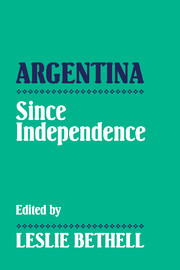Book contents
- Frontmatter
- Contents
- List of maps
- Preface
- 1 From independence to national organization
- 2 The growth of the Argentine economy, c. 1870–1914
- 3 Society and politics, 1880–1916
- 4 Argentina in 1914: The pampas, the interior, Buenos Aires
- 5 From the First World War to 1930
- 6 Argentina, 1930–1946
- 7 Argentina since 1946
- Bibliographical essays
- Index
6 - Argentina, 1930–1946
Published online by Cambridge University Press: 09 November 2009
- Frontmatter
- Contents
- List of maps
- Preface
- 1 From independence to national organization
- 2 The growth of the Argentine economy, c. 1870–1914
- 3 Society and politics, 1880–1916
- 4 Argentina in 1914: The pampas, the interior, Buenos Aires
- 5 From the First World War to 1930
- 6 Argentina, 1930–1946
- 7 Argentina since 1946
- Bibliographical essays
- Index
Summary
The year 1930 opens the gateway into modern Argentina. The military coup of September 1930 brought the collapse of constitutional government and initiated the long sequence of weak democracies, punctuated by coups d'état and military dictatorships, that remained the cardinal feature of Argentine politics into the 1980s. The plunge into depression in 1930 permanently shifted the path of economic development. Hitherto Argentina had subsisted as an informal dependency of Great Britain, supplying Britain with meats and grains and serving as a leading British market for coal, manufactured goods and, at least till 1914, capital exports. Beginning in 1930 the Victorian structure, already under growing pressure since the outbreak of the First World War, began to totter. From the depression came a decline of agrarian exports and an expansion of manufacturing – conditions that impaired the stability of the Anglo-Argentine relationship as they transformed the components of the Argentine economy. Social change of equal magnitude, and with the same enduring consequences, paralleled the economic shifts. The population of Argentina grew from 11.8 million in 1930 to 15.3 million in 1946, but the rate of growth declined. Falling rates of growth were a consequence of a substantial decline in the birth-rate, from 31.5 per thousand in 1920 to 24.7 per thousand in 1935, which contemporaries conventionally blamed on the depression. (In contrast death-rates fell only slightly, from 14.7 per thousand in 1920 to 12.5 per thousand in 1935.) Declining population growth was also a result of the end of mass European immigration.
- Type
- Chapter
- Information
- Argentina since Independence , pp. 173 - 242Publisher: Cambridge University PressPrint publication year: 1993
- 4
- Cited by



